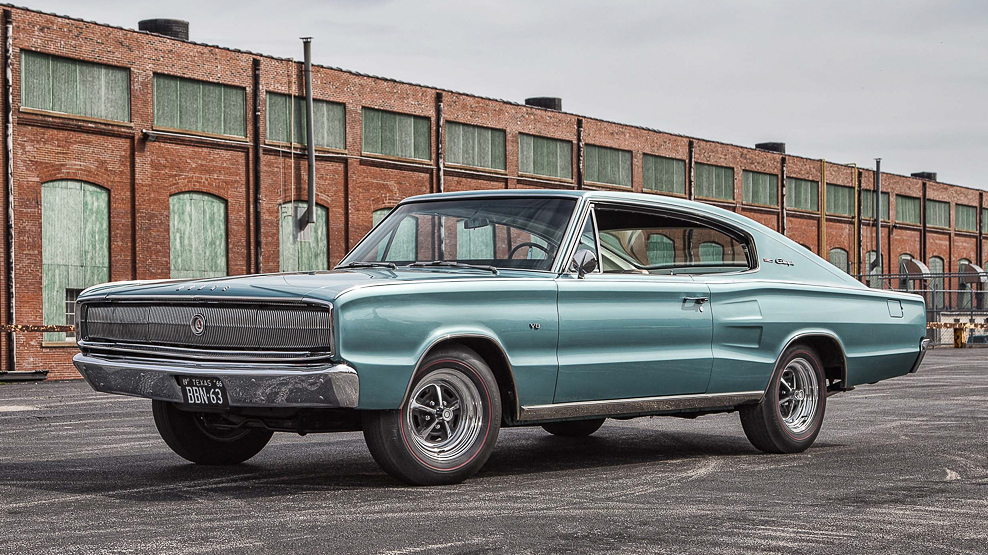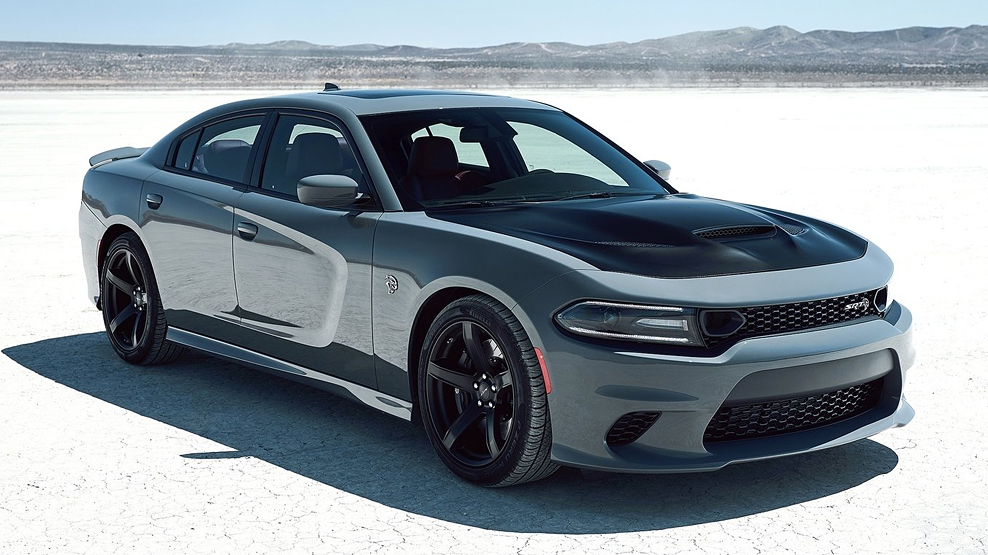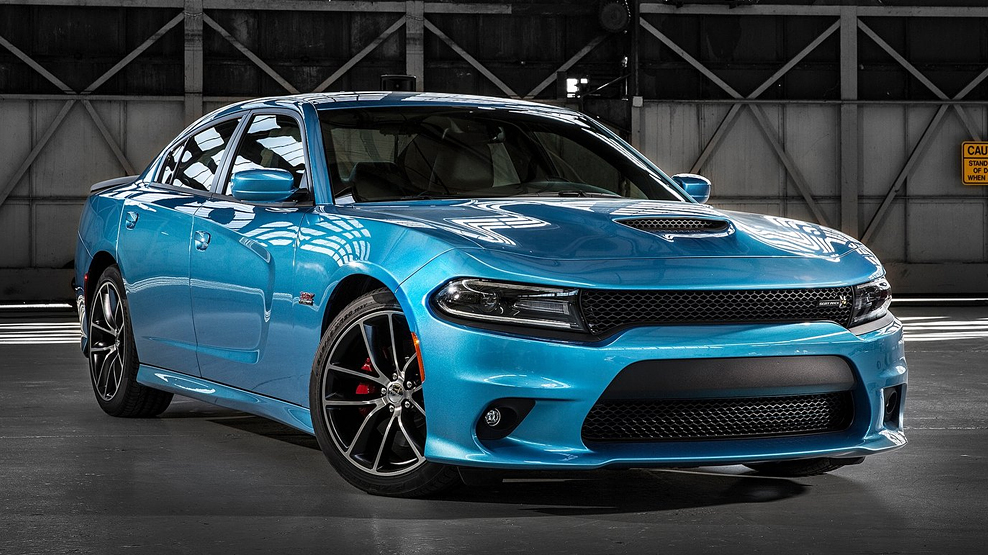By Peter Fitch, September 9, 2018
There are few automobiles more entrenched in muscle car history than the Dodge Charger. And unlike the plain Vanilla origins of many of Detroit’s other muscle cars, the Dodge Charger was built to make a statement right from the beginning. In fact, it wasn’t even a production car, it was a concept car built by Dodge to introduce the company’s massive new 426 HEMI engine. The year was 1946, and while the overpowered Charger did get noticed by the press, it didn’t grab the public’s imagination and nothing more came of it for almost 20 years.
The First Generation
 On January 1, 1966, viewers of the Rose Bowl were first introduced to the new “Leader of the Dodge Rebellion,” the 1966 Dodge Charger. Designed by renowned car stylist, Carl Cameron, the Charger was styled with a long, fastback roofline, full-width “electric shaver” grille, and concealed, rotating headlights. In the rear, a six-lamp taillight with chromed “CHARGER” lettering expanded across the length of the car. It was a strikingly good-looking car.
In the 1966 Chargers, four engines were offered: a base-model 318 cu in 2-barrel, a 361 cu in 2-barrel, a 383 cu in 4-barrel, and a 426 Hemi. Transmissions included a steering-mounted three-speed manual, a center console-mounted four-speed manual, or three-speed automatic. Those that we after some serious performance chose the four-speed manual powered by either the 383 or the 426 Hemi engines.
On January 1, 1966, viewers of the Rose Bowl were first introduced to the new “Leader of the Dodge Rebellion,” the 1966 Dodge Charger. Designed by renowned car stylist, Carl Cameron, the Charger was styled with a long, fastback roofline, full-width “electric shaver” grille, and concealed, rotating headlights. In the rear, a six-lamp taillight with chromed “CHARGER” lettering expanded across the length of the car. It was a strikingly good-looking car.
In the 1966 Chargers, four engines were offered: a base-model 318 cu in 2-barrel, a 361 cu in 2-barrel, a 383 cu in 4-barrel, and a 426 Hemi. Transmissions included a steering-mounted three-speed manual, a center console-mounted four-speed manual, or three-speed automatic. Those that we after some serious performance chose the four-speed manual powered by either the 383 or the 426 Hemi engines.
Fast Forward to the Seventh Generation
Since the original 1966 model, the Charger has evolved through several generations, some of which offered some lackluster performance. When the seventh generation Charger was introduced in 2011, things started to turn around. and it features a body style that borrows styling cues from the second-generation Chargers. The 2011 Charger model lineup consisted of three trims, the SE, R/T, and R/T AWD, and all equipped with a 3.6-liter Pentastar V-6. As the seventh generation Chargers became more popular, Dodge began adding engines and trims to the lineup. For model-year 2018, the Dodge Charger has nine trims to its name. The most powerful is the SRT Hellcat, powered by a supercharged 6.2-liter HEMI SRT Hellcat V8 engine, capable of generating 707 horsepower and 650 lb-ft of torque with a top speed of 204 mph. 2018 model yearChargers could be ordered in a spectrum of paint colors, some of which are from the original late 60s High-Impact Paint (HIP) collection – Plum Crazy, Go Mango, Yellow Jacket, Top Banana, Hemi Orange and Citron Yella.The SRT Group
 We know that SRT refers to “Street & Racing Technology” but we wondered what the history of the SRT emblem was. Fortunately, our friends at Lone Star Chrysler, Dodge, Jeep and Ram of San Antonio, TX came to the rescue. SRT is a high-performance group within Fiat Chrysler Automobiles (FCA). SRT began in 1989 as “Team Viper” to develop the Dodge Viper sportscar. It later merged with “Team Prowler” in 1997, the developers of the Plymouth Prowler, to become Specialty Vehicle Engineering (SVE). In 2004, SVE was renamed SRT. Today, SRT tunes and produces vehicles for the Chrysler, Dodge, and Jeep brands.
We know that SRT refers to “Street & Racing Technology” but we wondered what the history of the SRT emblem was. Fortunately, our friends at Lone Star Chrysler, Dodge, Jeep and Ram of San Antonio, TX came to the rescue. SRT is a high-performance group within Fiat Chrysler Automobiles (FCA). SRT began in 1989 as “Team Viper” to develop the Dodge Viper sportscar. It later merged with “Team Prowler” in 1997, the developers of the Plymouth Prowler, to become Specialty Vehicle Engineering (SVE). In 2004, SVE was renamed SRT. Today, SRT tunes and produces vehicles for the Chrysler, Dodge, and Jeep brands.
The Dodge Charger Daytona
Returning again for 2018 model year is the Dodge Charger Daytona. Having first been produced in 1969 to compete in NASCAR, the Dodge Charger Daytona back then was strictly a racing car. Since then, the model popped up as an LE (limited edition)several times, but in 2017, the Charger Daytona was officially revived and was powered by a 370 hp 5.7-liter HEMI engine, and Charger Daytona 392powered a 485 hp 6.4-liter HEMI SRT engine.A Popular Mod Platform
The Dodge Charger is also the second most popular vehicle modified by Mopar, FCA’s automobile parts division. A whole chunk of the Mopar Performance Parts catalog is dedicated to the Dodge Charger. These parts include a lot of customization accessories as well as performance equipment. Owners were encouraged to install most of this equipment, even things like cold-air induction systems and electronically controlled active performance exhaust systems.Learning to Race
Today, Dodge even has a racing school dedicated to it, the famous Bondurant Racing School, where Dodge consumers and drivers can learn how to handle the power of various Dodge Chargers in situations that require skill.







